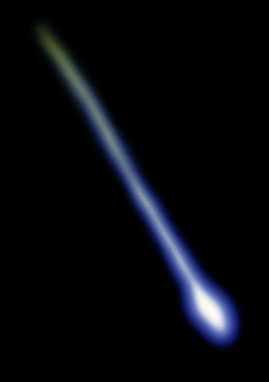Unusual Meteors
Meteor science is not without its unusual events. Reports of unusual meteors are not uncommon and there has been some work into these strange events. There are a few different types of strange meteors or strange meteor phenomena which I will explain. The phenomena listed include:
Double/Parallel Meteors
Curved Meteors
Meteors with sounds
Black Meteors
Fuzzy/Nebulous Meteors
Kinked Meteors
Double/Parallel meteors.
Double or Parallel meteors are best described as two meteors which appear simultaneously in the sky along the same path. This is a very rare occurrence, but observers do occasionally see this happen. The best theory to be put forward is that the meteors are formed by a recently separated body which has broken into two pieces still moving in the same orbit about the Sun. If the timing is very close, say if the paths are not quite parallel, or if one appears a few tenths of a second after the other one, it is possible that it is just a coincidence!!
Curved Meteors.
Many observers have surely seen a curved meteor in there hours observing. The subject of curved meteors is one of considerable debate in the world of meteor observing. Are they really curved, or are they optical illusions ?
Curved Meteors are usually seen in the Peripheral vision of an observer. The general explanation which is given to solve the phenomena of curved meteors is that when the observer turns to see a meteor at the edge of their field of view, the quick turning of the head disorientates the observer and the meteor is perceived as being curved in path. However, during our many hours of observing, we in the ASV's meteor section have seen some curved meteors pretty close to the center of the field of view in which we are observing. Observations of this phenomena are most welcome and are of scientific importance.

Meteors with sounds.
Sounds associated with meteors is a topic which has received its share of attention. The sounds in this case are not the usual delayed rumbles and ticks associated with the passage of a bolide, but sounds which are heard simultaneously with the passage of the meteor across the sky ! Sounds heard at the same time the meteor is visible are very controversial for a few very good reasons:
1. Sound travels much slower than light and as a result the meteor would, under
normal circumstances, be gone before the sound was heard.
2. Very little of the meteors energy is converted to acoustic energy. By the time
the sound has been attenuated by the atmosphere between the meteor and
the observer the sound should be barley audible, if able to be heard at all !
Even with all these facts in mind, observers remain adamant that they observer these effects. Usually the effects are heard from a remote and quiet sight where faint sounds can be heard better.
The best theory put forward so far is that energy from the meteor is propagated electromagnetically and is amplified and 're-transmitted' by a suitable nearby source such as metal fence wires or a metal shed roof even empty metal water tanks. This theory has not been proven though, but remains a possible solution to the problem
Many meteor professionals are skeptical about this. It is felt that it is equally possible that years of watching rockets and fireworks has conditioned us to expect sounds from rapidly moving lights in the sky. It is also possible that the location of the observer isn't as quiet as the observer has been led to believe.
Black Meteors.
Another curiosity which is occasionally reported is 'Black Meteors'. Black Meteors occur commonly just after watch starts or before it ends. Almost certainly black meteors are illusions of the physiological type, and effect in the eye as it settles down to dark adaptation or later on when fatigue starts to set in
It is also possible when you see a black meteor that you have seen an object fly in front of your field of vision. It may be as small as a bat of a bird fairly close, but it looks like an object far away. With the lack of light it can be hard to tell, I know I have been fooled more than once. This type of 'black meteor' is usually seen from a mildly light polluted sky where the background sky is slightly lit but foreground objects aren't, therefore the foreground object looks like a black object.
Fuzzy / Nebulous Meteors.
Occasionally in our group of observers we have seen what we call 'Fuzzy Meteors' 'Nebulous Meteors' or 'Diffuse Head Meteors'. They appear to have a large diffuse head and in some cased they look to be a foreground object, or more exactly they do not appear to be in the upper atmosphere. This "not in the upper atmosphere" effect is almost certainly an optical illusion as with the naked eye at night it is impossible to have that sensitive depth perception, but the fact that the meteors have a fuzzy of diffuse head appearance is unusual indeed.
When you see one you will know immediately what you have seen. They tend to look very much like a faint comet coma!! The usual magnitude we see them at is +2-3 and around about 15 arc minutes in diameter.
If you see something like this, whether it is brighter, fainter, smaller or larger please report it to us . It is very important
information.

Kinked Meteors.
Kinked meteors appear as one where the path is not a straight line, but takes a divergence, like in the image below.
The cause of this is not always known, however, atmospheric conditions or attributes of the meteoroid itself could have something to do with its flight through the atmosphere.

 Home
Home







